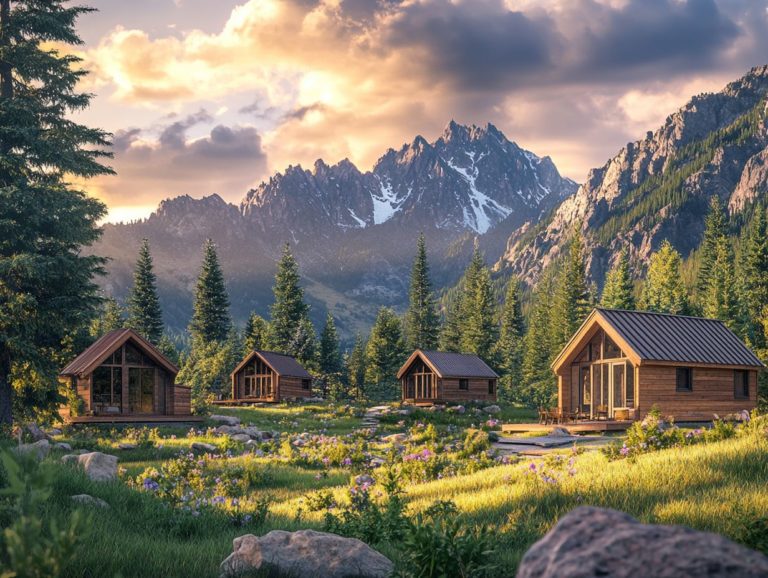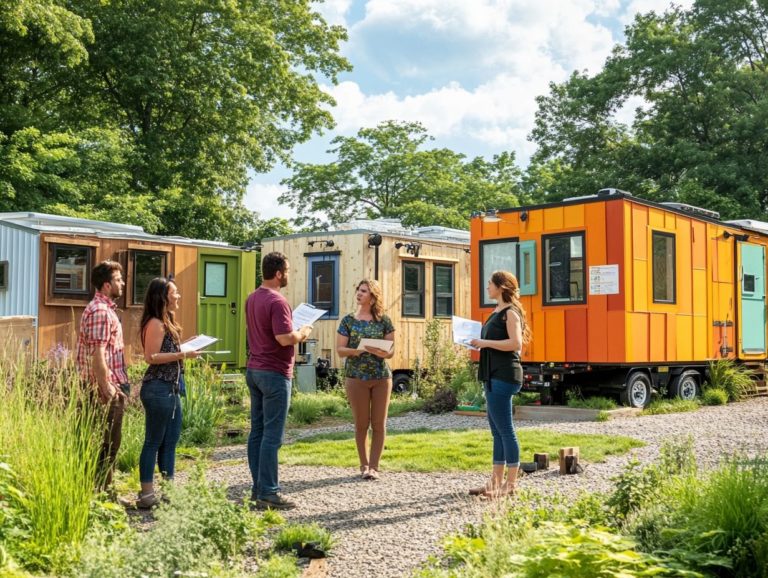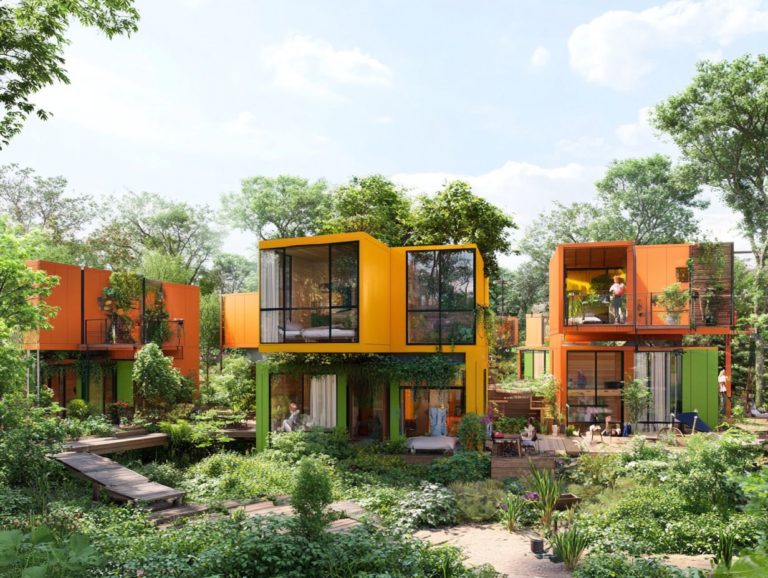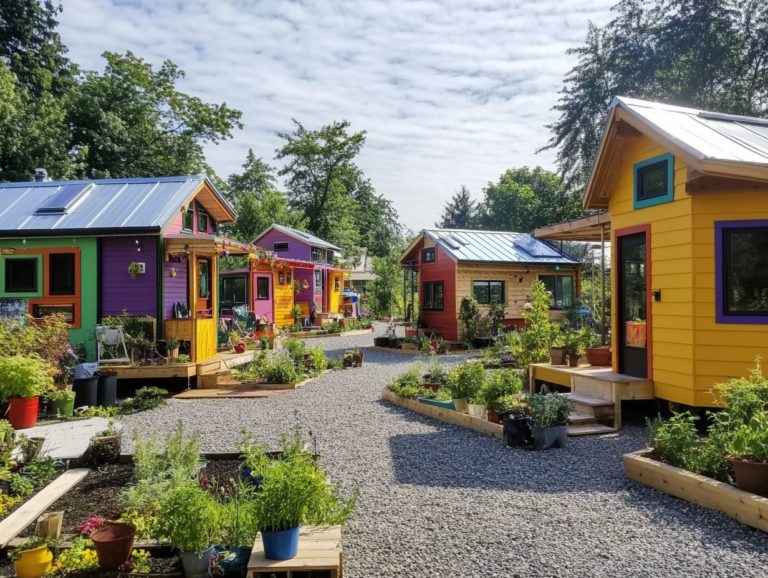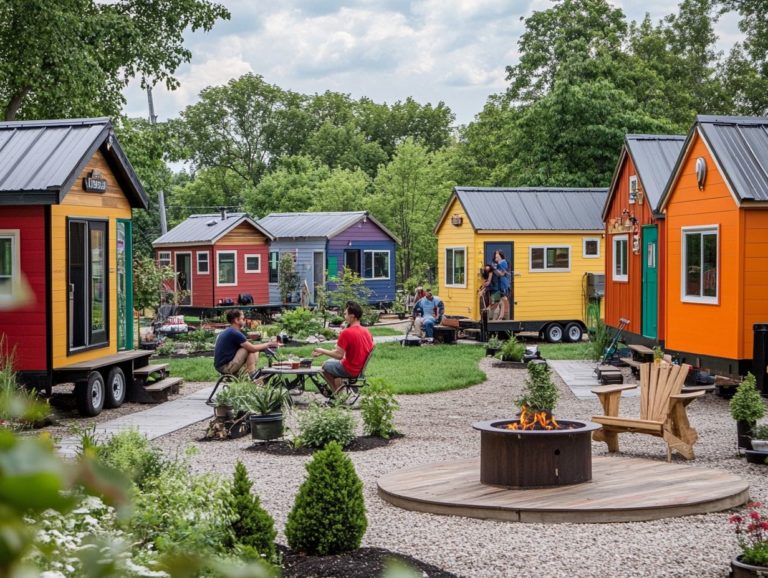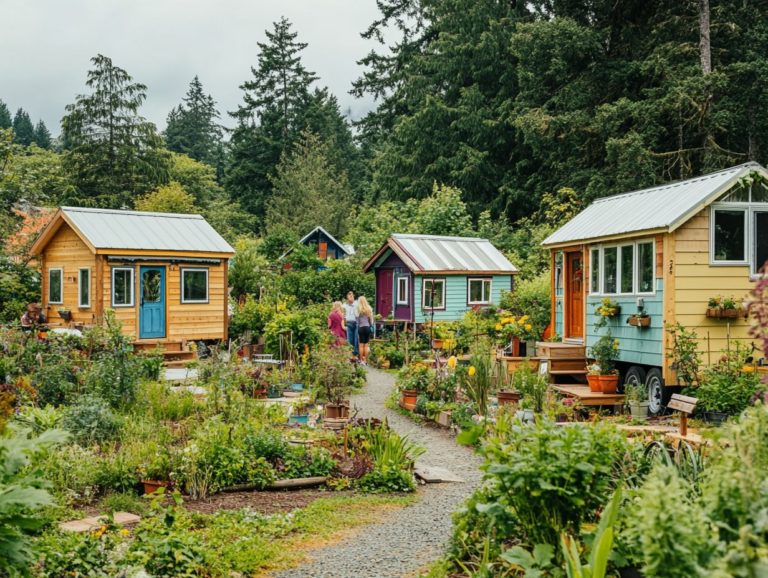Exploring the Benefits of Co-Living in Tiny Houses
In recent years, co-living in tiny houses has emerged as an innovative housing solution that beautifully marries a living community with efficient, minimalist lifestyle design.
Discover the amazing benefits of co-living! This exploration highlights strong social connections, along with financial and environmental advantages that enhance your lifestyle through eco-friendly practices.
You ll find guidance for discovering co-living opportunities while addressing potential challenges, like managing your personal space. Ultimately, you ll be equipped to determine if this unique lifestyle resonates with your aspirations.
Dive in to uncover the unique allure of this contemporary living arrangement, where community gardens play a vital role.
Contents
What You ll Gain from Co-Living:
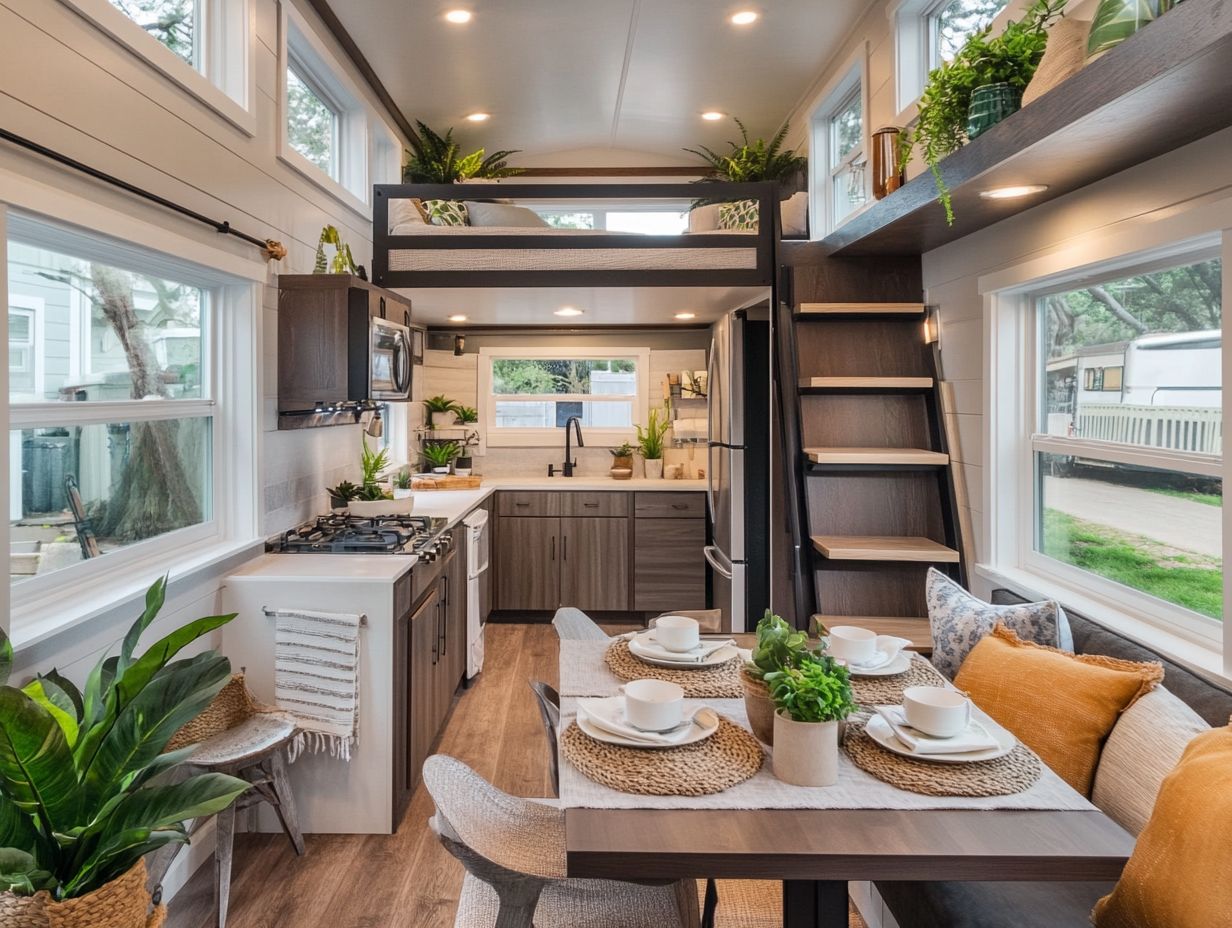
- Co-living in tiny homes creates a sense of community and fosters social connections, enriching the social fabric of the area.
- It offers financial and environmental benefits such as lower costs and a smaller ecological footprint.
- Numerous resources and platforms are available to help individuals find co-living opportunities in tiny house communities.
Defining Co-Living and Tiny Houses
Co-living in tiny houses represents a transformative journey towards sustainable living, where you can embrace a minimalist lifestyle while maximizing community connection within a supportive community.
These compact living environments help reduce your ecological footprint and foster a sense of belonging as you share resources and engage in cooperative initiatives, which are collaborative efforts within the community.
With urban housing becoming increasingly unaffordable, tiny house communities provide innovative solutions that prioritize eco-friendliness and financial freedom through alternative living options.
By choosing to live intentionally in mobile homes or co-living apartments, you can cultivate meaningful connections and enjoy a living experience that aligns with your values.
The essence of co-living and tiny houses lies in reducing waste and promoting sustainable practices. These dwellings typically feature energy-efficient designs, use renewable materials, and often incorporate communal gardens, which are shared spaces where you and your neighbors can grow food together. Additionally, exploring the benefits of custom tiny house designs can enhance your living experience.
Such a lifestyle not only lessens your carbon footprint but also nurtures a vibrant community spirit, as you come together with neighbors for shared meals and community engagement activities.
By prioritizing simplicity over excess, you can experience a heightened sense of fulfillment and purpose, allowing for a richer, more engaged life while embracing the ideals of environmental responsibility and nature connection.
The Benefits of Co-Living in Tiny Houses
Co-living in tiny houses presents a wealth of benefits, crafting unique journeys for those who seek supportive environments that nurture community connection and social interaction through resource sharing.
By sharing resources within a tiny house community, you can enjoy lower costs while embracing financial freedom and a sustainable lifestyle that minimizes your environmental impact.
This focus on cooperation fosters camaraderie and promotes collaborative living, enriching the experience for everyone involved and emphasizing community support.
Such an intentional living environment meets the needs of modern urban dwellers and champions eco-friendly practices that resonate with the increasing demand for affordable housing solutions.
Community and Social Connections
The essence of co-living in tiny houses is all about fostering strong community and social connections. You actively participate in a support network that nurtures a true sense of belonging.
By sharing your space with others, you engage in projects together that elevate your living experience. This allows you to forge meaningful connections that can blossom into lifelong friendships and enhance your mental health.
In these vibrant environments, the value of shared experiences is truly paramount, enriching the social connections among residents. Whether it s coming together for communal cooking nights or participating in organized outdoor activities, these interactions encourage bonding and foster collaboration.
This enables you to weave a rich tapestry of relationships and nurture community engagement.
The support systems within these tiny house communities are vital for navigating life’s challenges together, fostering community support. Whether it’s exchanging advice, lending a helping hand, or simply being a listening ear, these connections offer both emotional and practical support.
This transforms your living arrangement into a powerful network of community and camaraderie that enhances your overall well-being.
Financial and Environmental Benefits
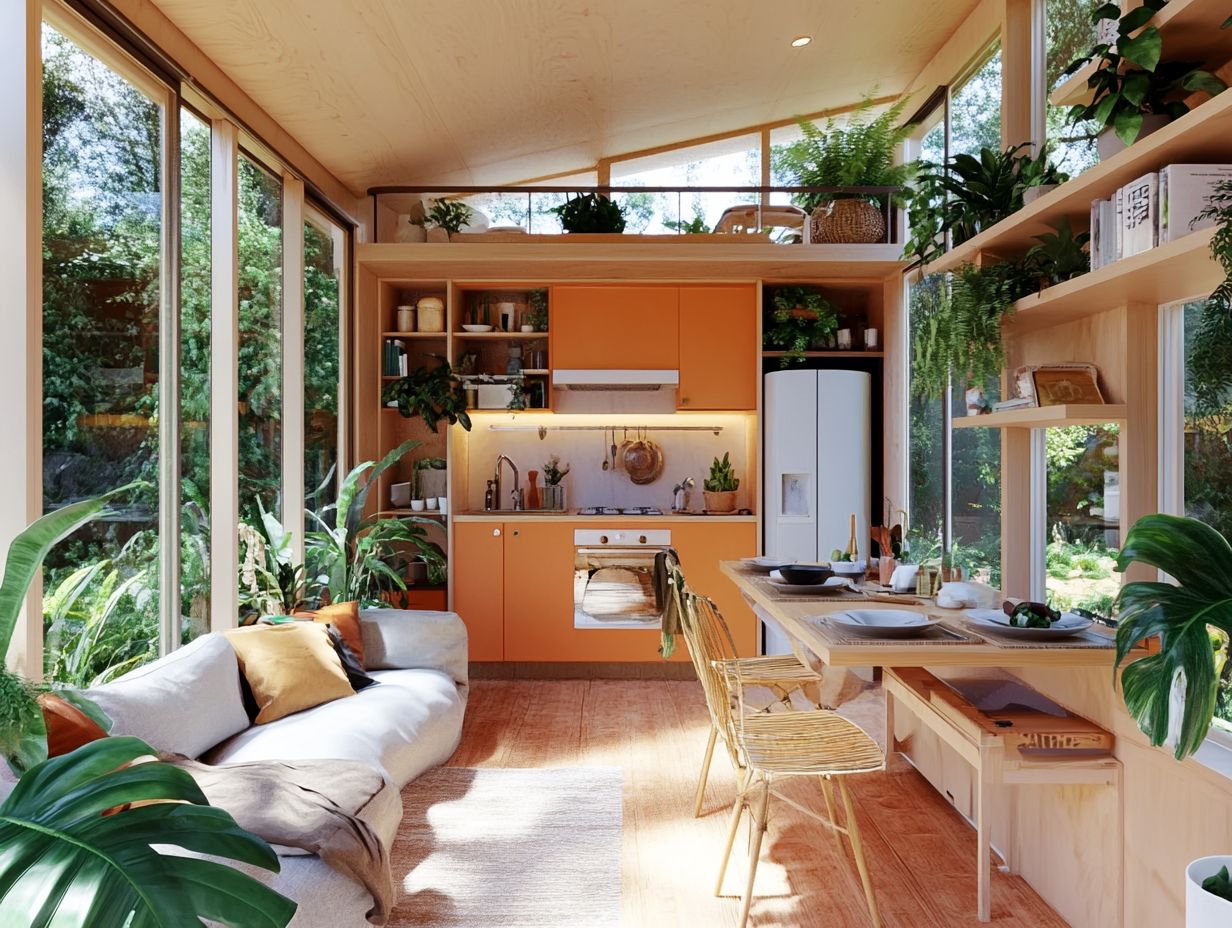
Co-living in tiny houses offers you a unique blend of financial freedom and environmental sustainability. This presents a cost-effective living solution that resonates with modern urban dwellers like yourself who value flexible living.
By sharing resources and embracing eco-friendly practices, you can significantly lower your expenses while minimizing your ecological footprint. This paves the way for housing alternatives that are both affordable and sustainable.
This innovative lifestyle invites you to enjoy community gardens, shared utilities, and delightful communal dining experiences. These result in substantial savings on your monthly bills while enhancing social connections.
As multiple households pool their resources for utilities and amenities, you ll find a vibrant sense of community and collaboration flourishing around you, fostering community engagement.
Imagine how a compact tiny home can transform your living space! The compact design of tiny homes encourages efficient use of space and resources, promoting a lifestyle that values sustainable living over consumerism, reducing clutter in your life.
Ultimately, these practices not only benefit your wallet but also contribute to a healthier planet. You can embrace a lifestyle that prioritizes sustainability and nature connection.
How to Find Co-Living Opportunities in Tiny Houses
Discovering co-living opportunities in tiny houses can be an enriching experience. More individuals are gravitating toward living communities that emphasize sustainable living and resource sharing.
By exploring specialized platforms or engaging with local initiatives, such as the Outpost Club or MicroLife Institute, you can uncover options that resonate with your values.
Consider incorporating features such as community gardens and cooperative living arrangements into your search. This allows you to find a space that truly reflects your commitment to a more sustainable lifestyle and flexible living.
Start your journey towards a sustainable lifestyle today explore co-living opportunities now!
Resources and Platforms for Co-Living
Numerous resources and platforms are at your fingertips to help you discover shared living options within tiny home communities. These platforms connect you with others who appreciate the shared living experience and embrace co-living. They offer access to listings, community guidelines, and insights into local rules about where and how you can live, giving you the power to make informed choices about your new living arrangements.
Among the most popular options are online marketplaces tailored for co-living. You can search by location, amenities, and unique community features that foster getting involved with neighbors. Social media groups and dedicated forums provide space for lively discussions about co-living experiences. This makes it effortless for you to connect with like-minded individuals who share a passion for sustainable living.
Many of these platforms also feature valuable tools such as budget calculators and community event calendars. These tools simplify the search for your ideal space while enhancing your sense of belonging and promoting community support. By engaging with these resources, you can seamlessly integrate into vibrant communities that prioritize collaboration and resource sharing.
Challenges and Considerations of Co-Living in Tiny Houses
Co-living in tiny houses brings a wealth of benefits, but it also introduces a distinct set of challenges and considerations that you must navigate as you adapt to this unique lifestyle.
Recognizing the importance of managing your personal space and establishing boundaries is vital for creating a harmonious living environment within a tiny home community.
It’s important to understand the legal and zoning rules. This understanding fosters a community that encourages getting involved with neighbors and enhances your living experience.
Managing Personal Space and Boundaries
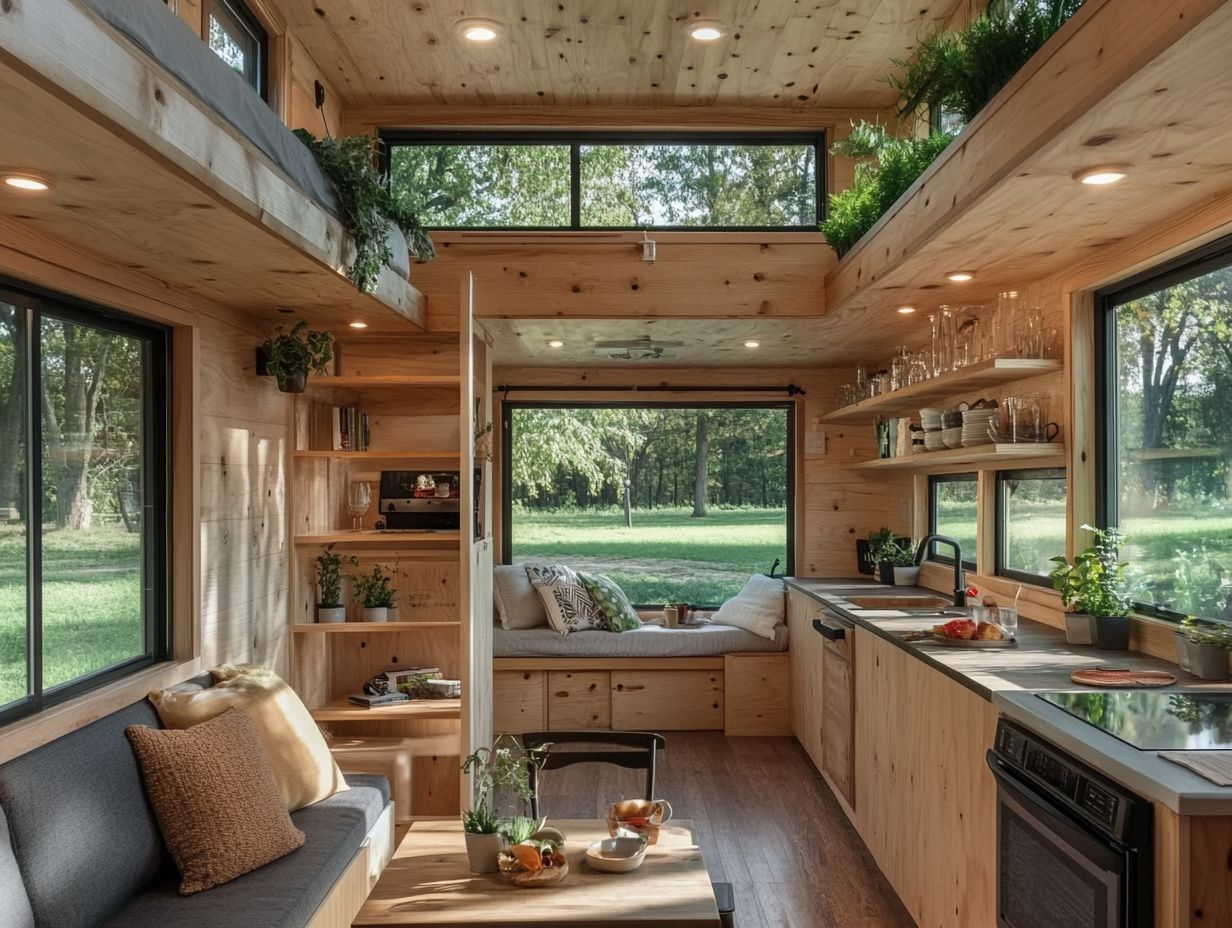
Managing your personal space is key to thriving in a tiny house community. You will use shared spaces while honoring the needs of your neighbors and fostering community connection.
By establishing clear guidelines and embracing intentional living, you can cultivate a respectful and supportive atmosphere. This significantly enhances your overall experience and promotes mental health.
This journey toward harmonious coexistence starts with open communication. You and your housemates should express your needs and preferences without hesitation, fostering community support.
Implementing regular check-ins can greatly enhance understanding and minimize potential conflicts. This enables everyone to adapt to each other’s daily routines while building a support community.
Designating specific areas for privacy is essential. These personal retreats offer invaluable moments of solitude, allowing for mental health rejuvenation. By emphasizing mutual respect for one another’s routines and belongings, you foster trust, making collaboration on community activities smoother.
Ultimately, these strategies not only enrich your relationships but also contribute to a vibrant co-living environment that enhances community support.
Legal and Zoning Considerations
Navigating legal and zoning considerations is essential if you’re looking to establish co-living arrangements in tiny houses. These factors directly influence the feasibility of your living situation.
By understanding housing regulations and local zoning laws, you can avoid potential conflicts and foster a supportive community.
- Check local rules to know what’s allowed.
- Understand minimum size requirements, land use designations, and safety codes.
- Engage with local authorities for guidance.
Challenges, such as obtaining permits or modifying existing zoning ordinances, can present significant hurdles. However, by actively participating in community discussions and advocating for more flexible regulations, you can contribute to creating environments that accommodate tiny houses and enhance community support and social cohesion.
Act now to ensure your living situation complies with local laws!
Is Co-Living in Tiny Houses Right for You?
Determining whether co-living in tiny houses is the right choice for you requires a thoughtful assessment of your lifestyle and goals. Consider various factors, such as your desire for community connection, your pursuit of financial freedom, and your commitment to embracing a minimalist lifestyle.
By reflecting on your unique journey, you can gain clarity on how this living arrangement resonates with your values and aspirations.
Assessing Your Lifestyle and Goals
Assessing your lifestyle and goals is crucial in figuring out whether co-living in tiny houses aligns with your personal values and aspirations. Taking the time to thoughtfully reflect on your priorities can bring clarity on whether this shared living space fits your unique journey.
Evaluating your financial goals can show how reduced living expenses in tiny houses could accelerate your path to stability or even wealth. Additionally, understanding the benefits of open floor plans in tiny houses can enhance your living experience. It’s essential to consider how involved you want to be in your community; shared experiences and relationships in co-living spaces can foster a profound sense of belonging and support.
Reflecting on your living preferences will help you determine if a minimalist lifestyle resonates with you or if more traditional accommodations might suit your needs better. Ultimately, these considerations encourage meaningful self-reflection, paving the way for impactful decisions about your living situation.
Frequently Asked Questions
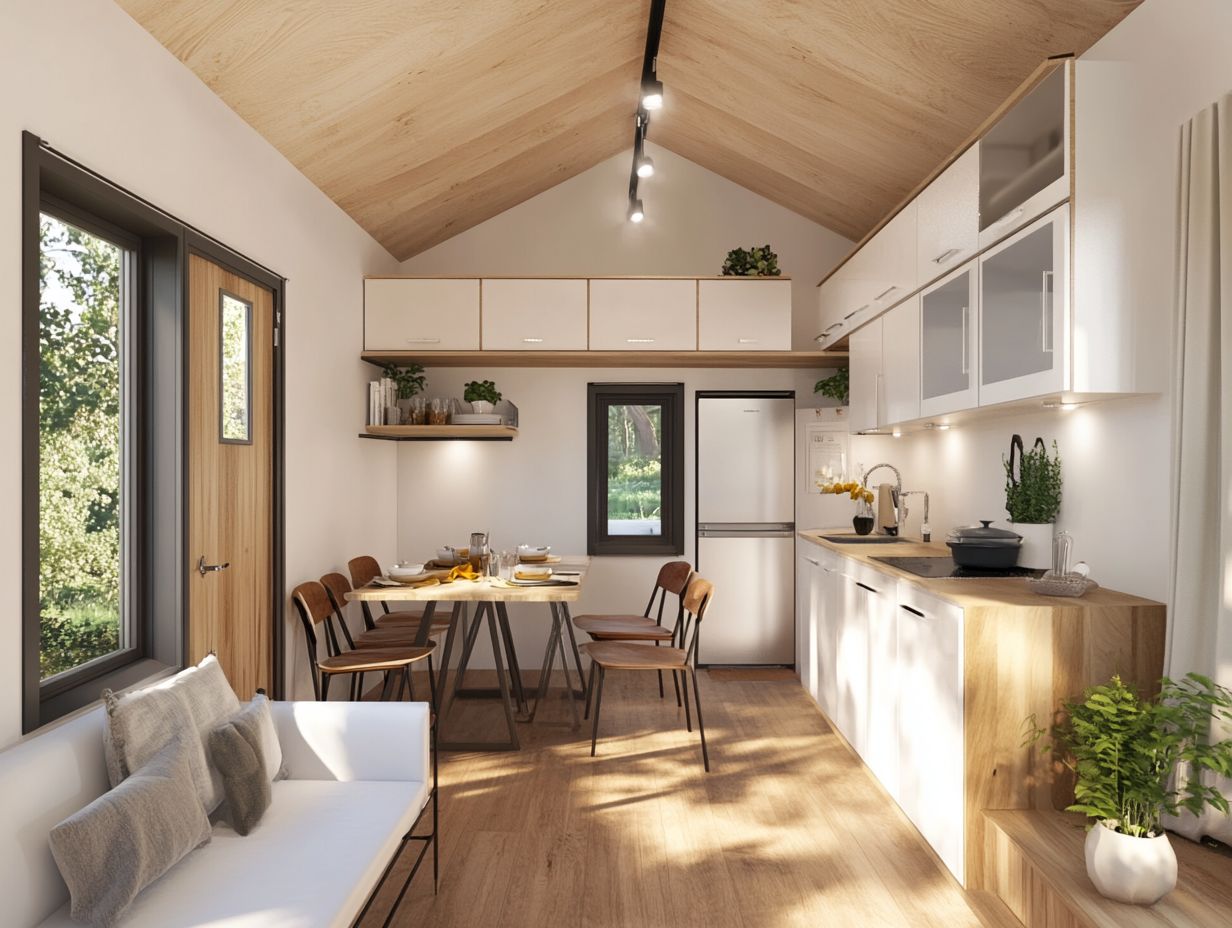
What is co-living in a tiny house?
Co-living in a tiny house is when individuals or families share a small living space, typically under 500 square feet. This type of living arrangement promotes a sense of community and encourages shared resources and responsibilities.
What are the benefits of co-living in a tiny house?
Some benefits include reduced living expenses, a smaller carbon footprint, and a stronger sense of community. It also allows for a simpler, more minimalist lifestyle.
How does co-living in a tiny house promote a sense of community?
Living in close quarters fosters a communal lifestyle, leading to shared meals, activities, and responsibilities. This creates a stronger sense of connection and support within the community.
Is co-living in a tiny house suitable for families?
Yes, co-living in a tiny house can be a great option for families. It promotes a family-oriented lifestyle and allows for closer relationships. However, it’s important to carefully consider the space to ensure it meets the needs of the entire family.
Are there any downsides to co-living in a tiny house?
Some potential downsides may include lack of privacy, limited storage space, and challenges in accommodating larger groups. Individuals should carefully consider their needs and preferences before committing to co-living in a tiny house.
How can I try co-living in a tiny house?
There are various ways to experience co-living, such as renting a shared tiny house, participating in a co-living community, or building your own tiny house with friends or family. It’s essential to research and consider your options before making a decision.
Are you ready to explore the possibilities of co-living in tiny houses? Consider joining a community or visiting a related website for more information!

